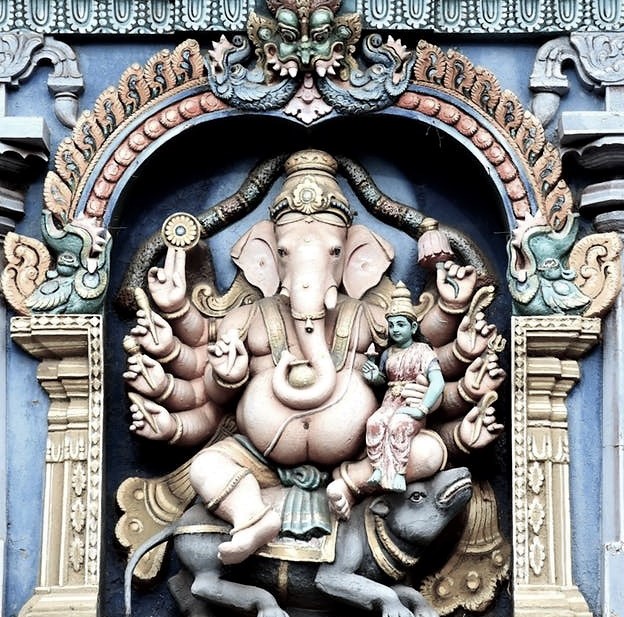- Special FeaturesFoundation YearThe earliest theory of its origins dates it to over 5,000 years of ageSthala TreeTheerthamRathamArchitectureKashmiri StyleOther SpecialityBody Part: Right hand, | Maha Shakthipeeth |
- Sthala Puran
Sharada Peeth translates to "the seat of Sharada", the Kashmiri name for the Hindu goddess Saraswati. "Sharada" could be also related to the proto-Nostratic terms "sarv", which means "flow or stream", and daw (blow, tip or rock), because it was located at the confluence of three streams.
The beginnings of Sharada Peeth are uncertain, and the question of origins difficult, because Sharada Peeth was both a temple and an educational institution. The earliest theory of its origins dates it to over 5,000 years in age, around the time of the earliest records of Neolithic sites in the flood plains of the Kashmir Valley. On this view, the site could not have been first constructed by the Indo-Aryan peoples, who are estimated to have arrived at the Ganges River around 1500 BCE. More conservative estimates suggest that it was built under the Kushan Empire (30 CE – 230 CE), and some others believe that its similarity to the Martand Sun Temple indicates that it was built by the Kashmiri king Lalitaditya (724 CE – 760 CE).[17][18] A third school of thought suggests that it was built not at once, but in stages.
Some historians have suggested that Sharada Peeth was never a centre of learning, on the basis that in present-day, there are no sizeable ruins from a supposed educational site. In response, it has been said that Sharda is prone to earthquakes, and debris from a collapsed abandoned university are likely to have been used by townspeople for other constructions.
- Architecture
Specifications
Width: 22 feet
Height (max): 16 feet
Site area: 4 kanals (0.5 acre)
The temple is built in the Kashmiri architectural style using red sandstone. Historical records of the temple's architecture are scarce. A late 19th-century account by the British archaeologist Aurel Stein describes the temple's walls as intact to a height of approximately 20 feet (6.1 m), and its pillars rising approximately 16 feet (4.9 m).
The compound is situated on a hill, approached on its west side through an imposing stone staircase. The facades are repetitive. Suggested reasons for this include that architects disliked plain outside walls or that even if the spire collapsed, a visitor would be able to tell what the temple originally looked like. The design of the temple is simple, with a plain conical Sharada spire. It sits on a raised plinth, 24 square feet (2.2 m2) in the area and 5.25 feet (1.60 m) in height. The walls of the cella recede 2 feet (0.61 m) from the edge of the plinth. The temple is surrounded by a quadrangle which measures 142 feet (43 m) by 94 feet (29 m). The quadrangle is enclosed by walls of 11 feet (3.4 m) in height and 6 feet (1.8 m) in width. On the north, east, and south, the cella walls are adorned by trefoil arches and supporting pilasters, which are constructed in high relief. Below these are small, trefoil-headed niches covered by double pediments. Although a pyramidal stone roof is more typical of Kashmiri architecture, the temple is covered by a low shingle roof in Stein's description. By the 21st century, the roof is no longer present, and the temple's interior is exposed to the elements. The temple appears imposing even outside the walled enclosure because of the plinths it is raised on to equalize the ground's uneven elevations. The north side of the wall contained a small recess, in which two ancient linga could be seen.
The cella's interior is plain and forms a square of 12.25 feet (3.73 m) on each side. It houses a large slab of stone measuring 6 feet (1.8 m) by 7 feet (2.1 m). This slab covers the holy spring where the goddess Sharada is believed to have appeared to rishi Shandilya. In the 19th century, this sacred spot was surmounted by a red cloth canopy and tinsel. The remainder of the interior was filled with ornaments of worship such as conches and bells.
- Alankar of Deity
- Prayers and BenefitsSpecial Vratas and PrayersOfferings to DeityStotras and Mantras
- Festivals
- Sodasha Upcharas
- Prasadhas
- Social ActivitiesAnnadhanMarriageEar BoringHead ShaveDanaasEducation FacilitiesSocial DrivesOther Activities
- Arjita Seva
- Tags

